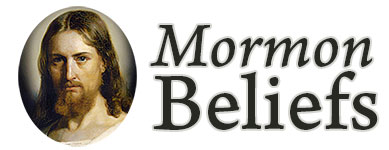 The Church of Jesus Christ of Latter-day Saints is unique among Christian denominations for its belief in continuing revelation and an open scriptural canon—two intertwining doctrines which often cause concern for those of other faiths. Continuing revelation—the belief that God speaks to His prophets and Apostles on the earth today—“mandates an open canon of scripture,” according to Elder Jeffrey R. Holland. Elder Dallin H. Oaks explained:
The Church of Jesus Christ of Latter-day Saints is unique among Christian denominations for its belief in continuing revelation and an open scriptural canon—two intertwining doctrines which often cause concern for those of other faiths. Continuing revelation—the belief that God speaks to His prophets and Apostles on the earth today—“mandates an open canon of scripture,” according to Elder Jeffrey R. Holland. Elder Dallin H. Oaks explained:
For us, the scriptures are not the ultimate source of knowledge, but what precedes the ultimate source. The ultimate knowledge comes by revelation. … The word of the Lord in the scriptures is like a lamp to guide our feet (see Psalms 119:105), and revelation is like a mighty force that increases the lamp’s illumination manyfold.
Scriptures are, literally, “words, both written and spoken, by holy men of God when moved upon by the Holy Ghost.” Thus, the Mormon scriptural canon is open because God is again speaking to the people of the earth through His prophets. An open scriptural canon includes other books besides the Bible as well as the words of modern-day prophets. The Mormon canon, which is often called the “standard works,” is the Bible, which includes the Old and New Testaments; the Book of Mormon: Another Testament of Jesus Christ; the Doctrine and Covenants; and the Pearl of Great Price. Mormon scriptures are more than the words of ancient prophets. They include the words—both written and spoken—of modern-day prophets. Every six months, in April and October, modern prophets and Apostles speak to The Church of Jesus Christ in what is called General Conference. Latter-day Saints are encouraged to study these words—which are printed in the LDS Church’s Ensign and Liahona magazines—in addition to the other books in the standard works.
Elder D. Todd Christofferson, said during the April 2010 Latter-day Saint General Conference:
Scriptures are revelation, and they will bring added revelation. Consider the magnitude of our blessing to have the Holy Bible and some 900 additional pages of scripture, including the Book of Mormon, the Doctrine and Covenants, and the Pearl of Great Price. Then consider that, in addition, the words of prophets spoken as they are moved upon by the Holy Ghost in settings such as this, which the Lord calls scripture (see Doctrine & Covenants 68:2–4), flow to us almost constantly by television, radio, Internet, satellite, CD, DVD, and in print. I suppose that never in history has a people been blessed with such a quantity of holy writ. And not only that, but every man, woman, and child may possess and study his or her own personal copy of these sacred texts, most in his or her own language.
Mormons believe that studying the words of prophets both ancient and modern is an integral part of their religion. As Elder Christofferson said:
In the end, the central purpose of all scripture is to fill our souls with faith in God the Father and in His Son, Jesus Christ—faith that They exist; faith in the Father’s plan for our immortality and eternal life; faith in the Atonement and Resurrection of Jesus Christ, which animates this plan of happiness; faith to make the gospel of Jesus Christ our way of life; and faith to come to know “the only true God, and Jesus Christ, whom [He has] sent” (John 17:3).
Revelation & Scriptures
Mormonism was founded upon the doctrine of continuing revelation. From the days of Adam, God has always spoken to His people through His prophets. The lines of communication between God and His prophet were again opened as The Church of Jesus Christ was restored to the earth through Joseph Smith. When this channel was restored, so was the open scriptural canon. The influx of additional scripture began with Joseph Smith, the organizing prophet of the Restoration. Donald Q. Cannon, Larry E. Dahl and John W. Welch—at the time, all professors at Brigham Young University—wrote:
Unlike traditional Christianity, which remains a religion of the book (the Bible), the restored gospel from its beginning has been a religion of books. Joseph Smith’s contribution to the concept of scripture is important and unique.
The translation of the Book of Mormon assured from the birth of the Church an openness to scriptural texts outside the Bible. Its appearance established that God still speaks through prophets and that the Bible is not an exhaustive collection of scripture. The Book of Mormon expressly cautions readers: “Because that ye have a Bible ye need not suppose that it contains all my words; neither need ye suppose that I have not caused more to be written.” (2 Nephi 29:10.)
The ancient prophet Nephi explains this in the Book of Mormon (2 Nephi 29:11):
For I [the Lord] command all men, both in the east and in the west, and in the north, and in the south, and in the islands of the sea, that they shall write the words which I speak unto them; for out of the books which shall be written I will judge the world, every man according to their works, according to that which is written.
And again, Nephi wrote (2 Nephi 31:3):
For my soul delighteth in plainness; for after this manner doth the Lord God work among the children of men. For the Lord God giveth light unto the understanding; for he speaketh unto men according to their language, unto their understanding.
To Mormons, it makes sense that the canon is not closed. Cannon, Dahl and Welch wrote:
In Paul’s day, there was no fixed collection of books, even among the Jews, that exclusively counted as scripture. Thus, Jude 1:14–15 quotes without reservation the nonbiblical book of Enoch as scripture. Indeed, not until the fourth century did the New Testament canon become fixed, and not until the Reformation in the sixteenth century did the church regard the Old Testament as Jerome did—that is, as the Hebrew canon.
Matthew, Paul, and Jesus himself led the way in showing, as Joseph Smith did, the need for expounding, searching, and interpreting the scriptures in light of current conditions and true perceptions (see Matthew 22:23–33; Matthew 24:27; John 5:39), and in issuing new commandments (see John 13:34; 1 Corinthians 6:7–8). They recognized the impossibility of restricting their spiritual knowledge to a finite number of pages. (See John 21:25.) Thus we see an open and complex idea of scripture in the early Christian movement that is comparable to the expanding view of scripture understood by Joseph Smith.
Indeed, as Elder Holland said:
One Protestant scholar has inquired tellingly into the erroneous doctrine of a closed canon. He writes: “On what biblical or historical grounds has the inspiration of God been limited to the written documents that the church now calls its Bible? … If the Spirit inspired only the written documents of the first century, does that mean that the same Spirit does not speak today in the church about matters that are of significant concern?” We humbly ask those same questions. …
Continuing revelation does not demean or discredit existing revelation. The Old Testament does not lose its value in our eyes when we are introduced to the New Testament, and the New Testament is only enhanced when we read the Book of Mormon: Another Testament of Jesus Christ. In considering the additional scripture accepted by Latter-day Saints, we might ask: Were those early Christians who for decades had access only to the primitive Gospel of Mark (generally considered the first of the New Testament Gospels to be written)—were they offended to receive the more detailed accounts set forth later by Matthew and Luke, to say nothing of the unprecedented passages and revelatory emphasis offered later yet by John? Surely they must have rejoiced that ever more convincing evidence of the divinity of Christ kept coming. And so do we rejoice.
Why Do We Need More Books of Scripture?
Many wonder what the additional scriptures of Mormonism offer. What information is contained in the Book of Mormon, the Doctrine and Covenants and the Pearl of Great Price? First, each book of scripture complements the others. Elder Oaks said:
… We believe that God will give new revelations on the meaning of scriptures previously canonized, meanings that were not evident in earlier times. … Public revelations on the meaning of earlier scriptures come through those we sustain as prophets, seers, and revelators. Examples of public revelations are the numerous additions and clarifications in the Joseph Smith Translation of the Bible and in the Doctrine and Covenants revelations on the meaning of Bible passages. (For example, see Doctrine & Covenants 77 on the book of Revelation and Doctrine & Covenants 113 on some prophecies in Isaiah.) These public revelations usually illuminate scriptural passages that are doctrinal rather than those that are descriptive or directive.
Canon, Dahl and Welch explain:
The pages of the Book of Mormon also contain interpretations, additions, and corrections to chapters from Isaiah, as well as quotations from heretofore unknown prophets of ancient Israel (Zenos and Zenock, for example), together with a precious account of the resurrected Savior’s personal ministry among inhabitants of ancient America. …
New scripture promotes faith in other sacred texts. Mormon 7:9 adds that the Nephite records were “written for the intent that ye may believe [the Bible].”
Latter-day scriptures also provide direction and guidance for the modern Church of Jesus Christ. Elder Boyd K. Packer said:
The revelations that came through the Prophet Joseph Smith, printed as scripture, laid the permanent foundation of the Church through which the gospel of Jesus Christ could go forth to “every nation” (2 Nephi 26:13).
The scriptures define the office of the Prophet and President and his Counselors, the Quorum of the Twelve Apostles, quorums of the Seventy, the Presiding Bishopric, and the stakes and wards and branches. They define the offices of the Melchizedek and Aaronic Priesthoods. They establish the channels through which inspiration and revelation can flow to the leaders and teachers and parents and to individuals.
The Doctrine & Covenants is one of those scriptures. A Liahona article explains:
Latter-day divine revelations and inspired declarations have been brought together in what we now call the Doctrine and Covenants. This special book of scripture contains the Lord’s counsel for the establishment and regulation of the kingdom of God on earth in the last days. Although most of the sections within the book are directed to members of the Church, the messages, warnings, and exhortations are for the benefit of all mankind. Through its pages, people everywhere are invited to hear the voice of the Lord Jesus Christ speaking to them for their temporal well-being and their everlasting salvation.
The Pearl of Great Price also contains scripture that support the Bible, including the book of Moses, the book of Abraham and the Prophet Joseph Smith’s inspired translation of Matthew 24. It also contains some writings of the Prophet Joseph, including an excerpt from his history as well as the Articles of Faith—which are 13 declarations of Mormon beliefs and doctrines.
Latter-day Saint Editions of the Combined Scriptures
Mormons believe that scripture study is an important part of learning about Jesus Christ and His plan for His children. Elder Packer said:
A knowledge of the scriptures is important. From them we learn about spiritual guidance.
It is for this reason that The Church of Jesus Christ undertook a massive project: to combine the standard works. Elder Packer said:
More than 40 years ago, it was determined to make the doctrine quickly and easily available to every member of the Church by preparing a Latter-day Saint edition of the scriptures. We set out to cross-reference the King James Bible with the Book of Mormon, the Doctrine and Covenants, and the Pearl of Great Price. The text of the King James Bible was left completely unaltered. …
Work was done centuries ago to prepare for our day. Ninety percent of the King James Bible is as translated by William Tyndale and John Wycliffe. … William Tyndale said, “I will cause a boy that driveth the plough shall know more of the Scripture than [the clergy].”
That is exactly what we had in mind when we began the scripture project: that every member of the Church could know the scriptures and understand the principles and doctrines to be found in them. We set out to do in our day what Tyndale and Wycliffe had done in theirs.
This was no easy task. Elder Packer continued:
To cross-reference more than 70,000 verses of scripture and provide footnotes and helps was known to be enormously difficult, perhaps even impossible. But it was begun. It took 12 years and the help of over 600 people to complete. Some were experts in Greek, Latin, and Hebrew or had a knowledge of ancient scriptures. But most were ordinary, faithful members of the Church.
The spirit of inspiration brooded over the work. The project would have been impossible without the computer. A remarkable system was designed to organize tens of thousands of footnotes to open the scriptures to every ploughboy and every ploughgirl.
With a subject-matter index, a member can, in just a few minutes, look up such words as atonement, repentance, Holy Ghost and find revealing references from all four scriptures.
The new LDS edition was more user-friendly and more conducive for in-depth studying. Also, the title of the Book of Mormon was expanded to: The Book of Mormon: Another Testament of Jesus Christ. Elder Packer said:
Most notable in the Topical Guide are the 18 pages, single-spaced, small print, under the heading “Jesus Christ,” the most comprehensive compilation of scriptural information on the name Jesus Christ that has ever been assembled in the history of the world. Follow these references, and you will open the door to whose Church this is, what it teaches and by what authority, all anchored to the sacred name of Jesus Christ, the Son of God, the Messiah, the Redeemer, our Lord.
Two new revelations were added to the Doctrine and Covenants—section 137, a vision given to Joseph Smith the Prophet on the occasion of the administration of the endowment, and section 138, President Joseph F. Smith’s vision of the redemption of the dead. Then, just as this work was being closed for printing, the marvelous revelation on the priesthood was received and announced in an official declaration (see Doctrine & Covenants Official Declaration 2), proving that the scriptures are not closed.
The Church of Jesus Christ again updated the scriptures in 2013. Elder Neil L. Andersen said:
The current edition of the scriptures, with its extensive study helps, will continue to serve Latter-day Saints very well. This new edition incorporates adjustments that will be a blessing to Church members in years to come, but members should not feel that they need to purchase a new set of scriptures, particularly since all of the adjustments are available in digital formats at no cost. Changes to the scriptural text include spelling, minor typographical, and punctuation corrections.
But the work on the scriptures was just beginning. The next task was to translate them into other languages. Elder Larry R. Lawrence, a member of the LDS Church’s Scriptures Committee, said:
The First Presidency and the Quorum of the Twelve are committed to providing, promoting, and preserving the scriptures for members throughout the world in their native languages. Scripture coordinators, translators, reviewers, and printers are working diligently each day to accomplish that goal.
As of March 2015, the Book of Mormon has been translated into 110 languages—Kosraean being the latest one. Three new translations of the Book of Mormon and 5 additional translations of the triple combination (the Book of Mormon, the Doctrine & Covenants and the Pearl of Great Price) will be published in 2015. In addition, several new translations of the scriptures will be announced over the next two years.
The Bible
The Holy Bible is the most recognized and revered book in all of Christianity. For hundreds of years, people have found the good word of God within its pages. Members of The Church of Jesus Christ of Latter-day Saints are no exception. Sometimes those of other faiths wonder if Mormons believe in the Bible, because […]
The Book of Mormon
What is the Book of Mormon? As part of the restoration of the gospel in these, the last days before the Second Coming of Christ, the Lord has revealed scriptures which until now have been hidden from the world. Among these scriptures is The Book of Mormon: Another Testament of Jesus Christ. The Book of Mormon […]
The Doctrine and Covenants
Mormon Scriptures: The Doctrine and Covenants The Doctrine and Covenants is a book of scripture containing revelations from the Lord to the Prophet Joseph Smith and to a few other latter-day prophets. It is unique in scripture because it is not a translation of ancient documents. The Doctrine and Covenants is one of four books […]
The Pearl of Great Price
Mormon Scriptures: The Pearl of Great Price The Pearl of Great Price contains the book of Moses, the book of Abraham, the Prophet Joseph Smith’s inspired translation of Matthew chapter 24, and some writings of the Prophet Joseph. The book of Moses is a small excerpt from Joseph Smith’s inspired translation of the Bible. It […]


